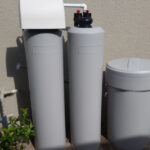According to the advice of industry experts, if you use a water softener in Florida to treat the water in your home, you should regularly check the amount of salt in the system. If you use a water softener on your water supply with the incorrect salt level, a salt bridge can form on the tank, and excessive crusting of the salt layer can cause problems. These concerns can arise if you use a water softener in Florida. If you take the given actions, you should not find it difficult to remove a salt bridge from water softeners.
What is a salt bridge?
Solid particles, such as salt, form salt bridges when they build up in the area between the inner walls of the tank and the salt itself. That creates a bridge between the two. Because of this barrier, no additional water can enter or exit the tank through this opening. As a consequence of this, the process of softening may be less successful, and other problems may appear.
Warning signs of a salt bridge
If your water softener in Florida suddenly stops working as it should, the problem may be a salt bridge. Water that is hard to the touch or causes soaps and detergents to behave differently may indicate that something is preventing the water softener from completing its regular regeneration cycle, even though the unit appears to function correctly. Water conditioning occurs during the resin bed’s whole regeneration cycle.
Assuming you have salt, the problem might be because of a few things:
- A crusted salt block or other impediment has developed between the brine and the resin tank.
- There might be a problem with the control valve. (if you have an automatic water softener).
- As a result of the salt bridge, the salt has begun to build a top layer instead of sinking to the bottom of the brine tank.
While any of these issues might prevent the water softener from starting its regeneration cycle, the most common is a salt bridge.
Where do salt bridges form?
Knowing the precise location of a salt bridge is one of the essential steps in the process of bringing about its demise. After repeatedly refilling the brine tank, one of the telltale signs that a salt bridge is present is a decrease in the water level. Second, if you haven’t maintained your water softener tank in Florida, you may have noticed its efficacy has reduced. You can remedy that by keeping the tank clean.
Visual inspection of the brine tank is the most effective method for determining a salt bridge’s presence. Check to see that there is no salt accumulation in the bottom of the tank or on the sides of it. A salt bridge forms when salt crystals pack together so densely.
How to remove a salt bridge
Once you find a salt bridge, the next step is to locate and eliminate any others that may exist. There are several distinct ways to tackle this situation. If you need professional help with water purification services in FL, follow the advice of Consumer Opinion experts and ensure that the best team is helping you solve your problems by reading reviews and recommendations. Also, it’s important to consider the cost of the water treatment services in Florida to ensure that it fits within your budget.
Dissolving the salt
Hot water destroys the majority of salt bridges. Transfer hot water from the sink into a bucket to get things rolling. Put on safety goggles and gloves to stay safe, then carefully pour hot water into the brine tank while protecting your eyes and hands. After the water has had a chance to settle, you can use a wooden spoon or something similar to break up the salt bridge.
Give the water in the tank ten to fifteen minutes to settle before draining it after removing the salt bridge. The salt will dissolve entirely as a direct consequence of this action. Dissolve all of the salt before proceeding with the operation.
Vacuum technology
Position the suction pipe with your shop vac within the brine tank to utilize a vacuum when demolishing a salt bridge. To remove a salt bridge, begin by turning on the vacuum.
Turn off the suction and withdraw the line from the tank once all the salt has been extracted. After that, pour hot water into the tank, then wait ten to fifteen minutes before draining the water out.
Using a brine tank cleaner
If the techniques mentioned above do not successfully remove the salt bridge, you may need a brine tank cleanser. With the assistance of one of these cleaners, any accumulation of salt or other solids that may have occurred within a brine tank can be rapidly and easily eliminated.
Be sure to read and follow the instructions on the bottle of the cleanser carefully before putting it into the brine tank with the hot water. Allow the vacuum to rest for the time specified in the instructions before emptying the tank. You must wait an additional ten to fifteen minutes after refilling the tank with clean water before you may use it again.
Conclusion
When the brine tank in a water softener in Florida doesn’t work properly, it’s usually because salt bridges are to blame. That is because salt bridges prevent the brine tanks from filling up with water, preventing them from performing their function. To remove a salt bridge, you just need to wash the afflicted region with hot water, use a vacuum cleaner, or clean the brine tank. All of these methods are simple. Refill the tank with clean water and give it at least ten to fifteen minutes for the water to settle after removing the salt bridge. Following these steps should help ensure that your brine tank is functioning properly. If you’re still unsure about the quality of your water, you can book an online water test in Florida.








